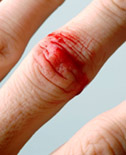Introduction
 The
skin is the body’s largest organ and is responsible for protection,
temperature regulation, and sensation. As skin ages, it becomes
dehydrated, has decreased blood flow and loses its elasticity. The
various
layers of the skin which includes the epidermis, dermis, and subcutaneous tissue
becomes more susceptible to an
injury as a result of these changes. An everyday accident such as bumping your arm on the refrigerator
could even result in damage to the skin!
The
skin is the body’s largest organ and is responsible for protection,
temperature regulation, and sensation. As skin ages, it becomes
dehydrated, has decreased blood flow and loses its elasticity. The
various
layers of the skin which includes the epidermis, dermis, and subcutaneous tissue
becomes more susceptible to an
injury as a result of these changes. An everyday accident such as bumping your arm on the refrigerator
could even result in damage to the skin!
Wound care is a specialty area of physical therapy that
involves prevention, assessment, and treatment of acute or
chronic wounds. Physical therapists often come across
patient populations that may be more susceptible to the
development of wounds. Therefore, they have the opportunity
to help these patients minimize or prevent such occurrences.
They accomplish this by helping patients understand how
pre-morbid conditions such as diabetes or vascular
insufficiency can influence the body’s response to external
stimuli. They also educate and teach patients who have
diabetes or poor venous return how to regularly perform foot
inspections, avoid prolonged positions and increase their
activity levels so they minimize their likelihood of
developing a wound.
Types of Wounds
Vascular wounds which are due to venous insufficiency are characteristically
associated with edema, a large amount of drainage, hemosidering
staining (brown discoloration), and pain when the foot is in a dependent
position. Treatment generally includes compression bandages such as Unna boot or Profore wrapping.
Arterial insufficiency wounds occur
more often distally, have pain from intermittent claudication, and
can become necrotic or gangrenous. Revascularization needs to take
place for these wounds to heal.
Neuropathic wounds or “diabetic wounds” are generally located on the
plantar surface of the foot and involve peripheral neuropathy. These
wounds may be due to trauma, prolonged pressure, or poor foot care.
The most common type of wound is a pressure ulcer and is more
prevalent in acute care or long term care settings where a patient
may have impaired mobility, decreased mental status, incontinence,
or non-compliance. The importance of repositioning, using
appropriate cushions and mattresses, and giving attention to bony
prominences may prevent prolonged pressure and development of a
chronic wound.
Understanding the Wound
Assessment of a wound includes staging a pressure ulcer (Stage I
superficial to Stage IV deep), identifying tissue quality (necrotic
tissue, slough), measuring and identifying drainage (serous or
purulent), and describing odor. Measuring for sinus tracts, undermining, and tunneling
is also necessary. Being able to recognize an infection can effect the treatment
methods used in wound care as well.
Intervention
 The treatment of wounds can change with the introduction of every new type
of dressing or chemical. While it is sometimes indicated, the use of betadine whirlpools in wound care is no longer the popular
alternative to treating infection or hydrating eschar. Based on the
type, location and assessed characteristics of any individual wound,
the therapist and doctor must decide on an appropriate treatment
plan. The key goals in determining how to treat a wound are to
reduce risk factors, eliminate non-viable tissue, increase mobility
of soft tissues, protect viable tissue as it develops, and to
educate patients and caregivers in order to prevent further recurrence.
The treatment of wounds can change with the introduction of every new type
of dressing or chemical. While it is sometimes indicated, the use of betadine whirlpools in wound care is no longer the popular
alternative to treating infection or hydrating eschar. Based on the
type, location and assessed characteristics of any individual wound,
the therapist and doctor must decide on an appropriate treatment
plan. The key goals in determining how to treat a wound are to
reduce risk factors, eliminate non-viable tissue, increase mobility
of soft tissues, protect viable tissue as it develops, and to
educate patients and caregivers in order to prevent further recurrence.
Listed below are various dressing types and their uses (not an
all-inclusive list):
• Absorptives: for drainage
• Alginates: for drainage and uneven borders or tunneling
• Film Dressings: for shallow wounds with potential to auto-debride
• Foams: for absorbing drainage
• Hydrogels: to give moisture to the wound
• Hydrocolloids: clean wounds and promote auto-debridement
• Antimicrobials: for infected wounds
• Compression dressings: for wounds due to venous disease
Listed here are other treatment options for wound care (not an
all-inclusive list):
• Whirlpool
• Pulsed Lavage
• Ultrasound assisted wound treatment
• Infrared light therapy
• Electrical Stimulation
• Vacuum Assisted Closure
Last revised: April 10, 2008
by Ryan Garman, MPT
References:
Birmingham, J.V. (2006). Complete Wound Care:
Prevent-Assess-Debride-Treat. JVB Enterprises, Inc.


 The
skin is the body’s largest organ and is responsible for protection,
temperature regulation, and sensation. As skin ages, it becomes
dehydrated, has decreased blood flow and loses its elasticity. The
various
layers of the skin which includes the epidermis, dermis, and subcutaneous tissue
becomes more susceptible to an
injury as a result of these changes. An everyday accident such as bumping your arm on the refrigerator
could even result in damage to the skin!
The
skin is the body’s largest organ and is responsible for protection,
temperature regulation, and sensation. As skin ages, it becomes
dehydrated, has decreased blood flow and loses its elasticity. The
various
layers of the skin which includes the epidermis, dermis, and subcutaneous tissue
becomes more susceptible to an
injury as a result of these changes. An everyday accident such as bumping your arm on the refrigerator
could even result in damage to the skin! The treatment of wounds can change with the introduction of every new type
of dressing or chemical. While it is sometimes indicated, the use of betadine whirlpools in wound care is no longer the popular
alternative to treating infection or hydrating eschar. Based on the
type, location and assessed characteristics of any individual wound,
the therapist and doctor must decide on an appropriate treatment
plan. The key goals in determining how to treat a wound are to
reduce risk factors, eliminate non-viable tissue, increase mobility
of soft tissues, protect viable tissue as it develops, and to
educate patients and caregivers in order to prevent further recurrence.
The treatment of wounds can change with the introduction of every new type
of dressing or chemical. While it is sometimes indicated, the use of betadine whirlpools in wound care is no longer the popular
alternative to treating infection or hydrating eschar. Based on the
type, location and assessed characteristics of any individual wound,
the therapist and doctor must decide on an appropriate treatment
plan. The key goals in determining how to treat a wound are to
reduce risk factors, eliminate non-viable tissue, increase mobility
of soft tissues, protect viable tissue as it develops, and to
educate patients and caregivers in order to prevent further recurrence.




